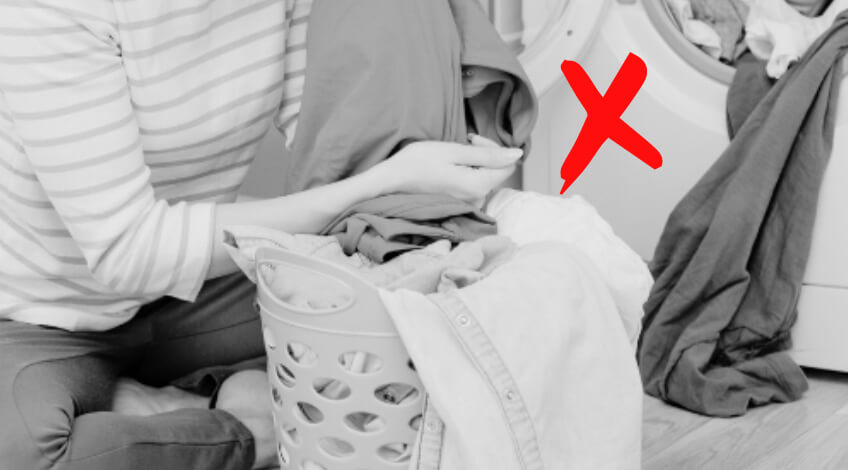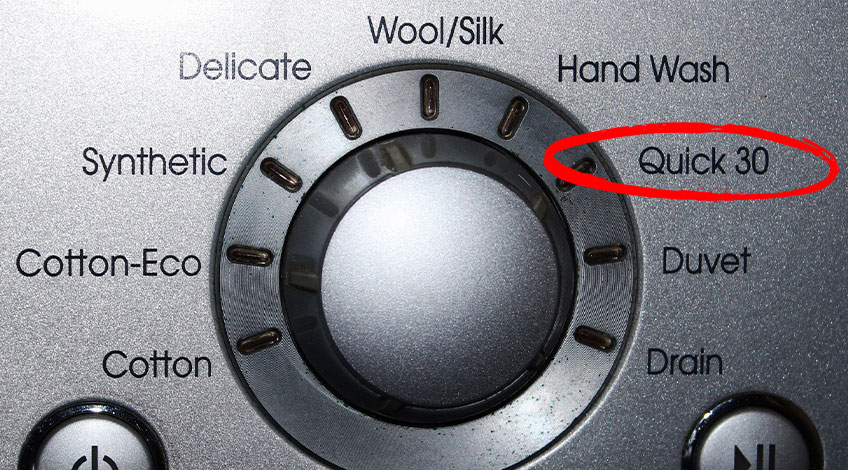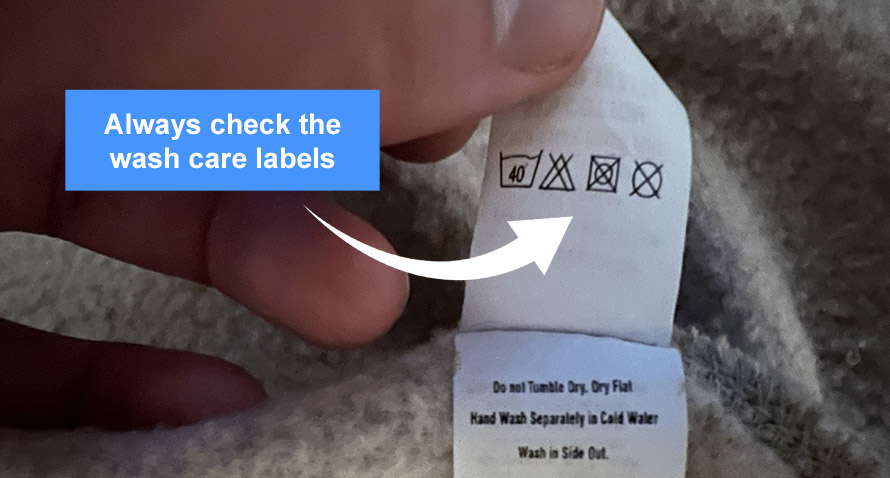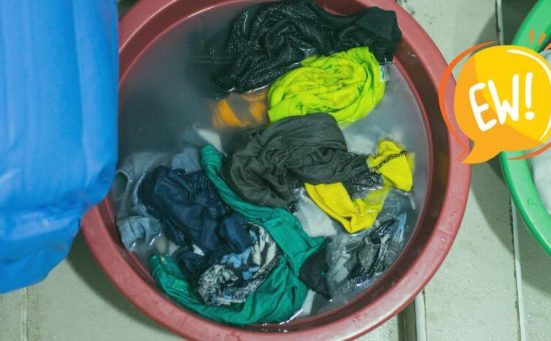
Can You Wash Black And White Clothes Together?
No, it’s not a good idea to wash your black and white clothes together.
Why, you ask? Well, that’s what we’re here to explain. Mixing these contrasting shades in the washer can lead to a laundry disaster, leaving you with discoloured garments.
In this article, we’ll talk about why you should sort your clothes by colour, give you some tips if you really need to do one load, and share other advice to help you keep your clothes looking their best.
Is It Okay To Mix Your Black And White Clothes In The Washer?
Life can be hectic, and sometimes, you just want to toss all your clothes into the washer and be done with it. But hold on!
Washing your black and white clothes together is NOT a good idea. The main reason is the potential for colour bleeding.

Darker-coloured garments, especially new ones, can release dye during the wash. This dye can stain your lighter clothes or turn them into unintentional shades of grey. Of course, if you’re 100% sure your clothes are colourfast (meaning their dye won’t bleed), then you can give it a try, but it’s a risk.
What About Tumble Drying Whites And Coloured Garments Together? Is It Safe?
Now you might be thinking, “Okay, I won’t wash them together, but can I dry them together?” Unfortunately, the answer is still a cautious “no.”
Why?
Because colour transfer can still happen, mainly due to the agitation between fabrics and the dryer’s temperature.
To be on the safe side, separate your garments by colour when tumble drying. If you must dry them together, go for a cold or low-heat setting to minimise the risk of colour transfer.
How To Wash White And Black Clothes
Now that you know the importance of separating your black and white clothes, if you still need to mix them in one wash load, here are the things you should remember:
Never Mix New Clothes With Your Usual Laundry
First things first, don’t ever wash your new clothes with your regular laundry, especially when you’re mixing colours. New clothes often contain residual dyes that need to be rinsed off.
Those vibrant, eye-catching hues may still have some excess dye that can wreak havoc on your other garments. So, give new clothes a few washes of their own before you introduce them to the rest of your wardrobe.
TIP: Want to check if your new clothes bleed dye? Soak the garments in cold water for an hour. If the water is still clear, it’s possible that your clothes are colour-fast.
Wash Your Clothes Inside Out
Turning your clothes inside out before washing serves as a handy precaution.
By doing this, you shield the visible part of your garment from potential colour transfers. If any dye does escape, it’s more likely to stain the inner part, which is less noticeable.
SEE ALSO: Is It Better To Wash Clothes Inside Out? (yes! here’s why)
Choose The Cold Wash Setting
While hot water can be great for removing stains, it can also break down the dyes in your fabrics. This breakdown makes colour transfer more likely, which is precisely what we’re trying to avoid.
Hence, it’s best to do cold washes, typically around 30 degrees Celsius or lower, to preserve the vibrant colours in your clothes.

Keep in mind that cold water may not be as effective at stain removal, so consider pre-treating any stubborn spots.
SEE ALSO: What Temperature Is A Cold Wash? (here’s what you need to know)
Choose The Quick Wash Option
Longer wash cycles increase the chances of colour bleeding, especially when you’re washing different colours together.
Quick wash settings, which typically run for 14 minutes to an hour, are a safer bet.

However, they might not be as effective at killing bacteria or removing tough stains. If you’re dealing with stains, it’s best to spot-treat them before tossing your fabrics into the washer.
NOTE: Quick washes are not as efficient in killing bacteria and removing stains from clothing. Hence, it’s best that you spot-treat any spots before putting your fabrics in the washer.
Never Use Bleach
Bleach can work wonders on white clothes, making them appear brighter and banishing stubborn stains.
But when you’re mixing whites with darks, steer clear of bleach. It could stain or strip the dye from your coloured clothing.
Use Colour Catcher Sheets
Last but not least, consider using colour catcher sheets. These handy laundry products are designed to safeguard the colour of your clothing by absorbing loose dye.
If any colour transfer occurs, the colour catcher sheet will soak it up, sparing your clothes from potential stains.
- Colour Catcher – The No.1 laundry sheet for colour protection in the UK & ROI*
- Protection - The sheet acts as a magnet to trap loose dye, assuring maximum protection against discolouration and colour runs
Tips To Sorting Your Clothes
Sorting your laundry is key to keeping your clothes looking their best. Here are some quick tips on how to do it effectively:
By Colour
Sorting by colour is crucial to prevent colour transfer. Keep your whites with whites, darks with darks, and colours with colours.
By Material
Different fabrics have different care requirements. Always check the care labels on your garments and follow the recommended washing instructions. Some materials may require gentle cycles or cold water to maintain their quality.

By Dirtiness
It’s a good practice to wash heavily soiled or stained clothes separately from cleaner ones. This prevents dirt and grime from transferring to your other garments, ensuring that your laundry stays fresh and vibrant.
Keep Your Clothes Their Intended Colour!
Washing black and white clothes together can lead to colour issues that may leave your wardrobe looking drab or stained.
Avoid the headache and follow the tips above to keep your clothes in top-notch condition. Remember, a little extra care in the laundry room goes a long way in preserving your clothes in the long run!
Frequently Asked Questions
If you accidentally wash black with white clothes, the dark colours can bleed onto the white fabric, causing discoloration or staining.
Colour bleed stains aren’t always permanent, but they can be challenging to remove. It depends on the fabric and how quickly you take action to treat the stain.
To remove colour bleeds from clothes, you can try using colour-safe bleach, vinegar, or specialised stain removers. Follow the care label instructions and test in an inconspicuous area first.
If clothes bleed in the wash, immediately stop the cycle to prevent further spreading. Re-wash them separately and consider using colour-catching sheets in future washes.
Cold water is generally better for stains, as hot water can set some stains. Cold water is milder on fabrics and is less likely to cause colours to bleed.
Also, follow us on Pinterest ...




